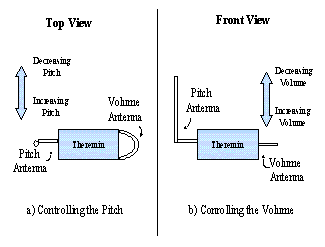|
|
 |
|
|
Research |
|
|
| |
 |
 |
|
The Theremin
The
Theremin is an electronic musical instrument which is played
without physical contact. The Theremin was invented in 1919 by
Lev Sergeyevich Termen, who later changed his name to Leon
Theremin. A typical Theremin resembles a box with two
protruding metal antennae, one on either side. A single
musical tone is controlled through interactions with the
antennae. One antenna controls pitch, the other volume. As the
musician's hand approaches the pitch antenna, the pitch of the
sound increases (Fig.1 (a)). As the other hand approaches the
volume antenna, the volume of the sound decreases(Fig.1 (b)).
Most Theremins are capable of producing a 5 octave range.
| |
|
 |
 |
|

Figure 1: Controlling the Sound from the
Theremin | |
|
 |
The Theremin-Playing Robot
Fig.2
shows the system overview. A human plays notes on the
keyboard, which sends information to the Theremin-Playing
Module (TPM) using the General MIDI format. This information
indicates which note has been played. The TPM uses this code
to determine the desired pitch, or frequency, in Hertz. The
keyboard also sends messages indicating the volume of the
note, as well as control messages that affect the motion of
the robot's arms. The TPM samples the audio signal from the
Theremin, and using the desired pitch and volume information,
computes position commands to send to the Arm Controller
modules. These modules move the arms’ end-effectors to
the desired positions. |
|
|
The core of the TPM is an audio-servo loop
(Fig.3). This loop moves the robot's right arm (the Pitch arm)
such that the Theremin emits a note of a desired pitch. The
audio signal from the Theremin is sampled by the PCs sound
card at 8kHz. The sampled audio data is then transformed to
frequency information using a Fast Fourier Transform (FFT).
512 data-points, zero padded to 2048, are transformed each
time. This provides a spectrum with frequency resolution of
3.90625 Hz. The frequency component with the largest magnitude
is then taken to be the fundamental frequency of the
Theremin's audio signal, represented as f in Fig.3.
| |
|
 |
 |
|
Performance
As
mentioned previously, the Theremin is a difficult instrument to
play. The Theremin's sensitivity to environmental changes requires
the player to have ``perfect pitch''---that is, the ability to
identify exactly the note being played by an instrument. The TPM
effectively gives ISAC ``perfect pitch.'' The performance of the
robot then becomes function of its servo control bandwidth. ISAC's
softarms are not ideal in this respect; their control bandwidth is
quite limited. However, the arms are human-like in appearance and
therefore may be more appealing to watch from an entertainment
perspective. Additionally, the flexing of the muscles during the
oscillatory vibrato is quite natural appearing and easy to obtain
with a rubbertuator-based humanoid robot. Electro-mechanical arms
can vibrate (although it is not conducive to longevity) but they are
very stiff and ``robot-like'' in high frequency movement. A video of
ISAC playing the Theremin was shown at a Theremin Festival in
Portland, Maine, in 1997. The conference attendees were mainly
Theremin musicians with an appreciation for the difficulties in
playing the Theremin. They enjoyed the robot's perfect pitch and
were amused by the vibrato---vibrato is often over-used by beginning
Thereminists to cover up ``sour'' notes.
Publications
A. Alford, S.
Northrup, K. Kawamura, K-W. Chan, and J. Barile. "Music Playing
Robot." Proceedings of the 1999 International Conference on Field
and Service Robotics (FSR '99). August 29-31, 1999. Pittsburgh,
PA, pp. 174-178. |
|

